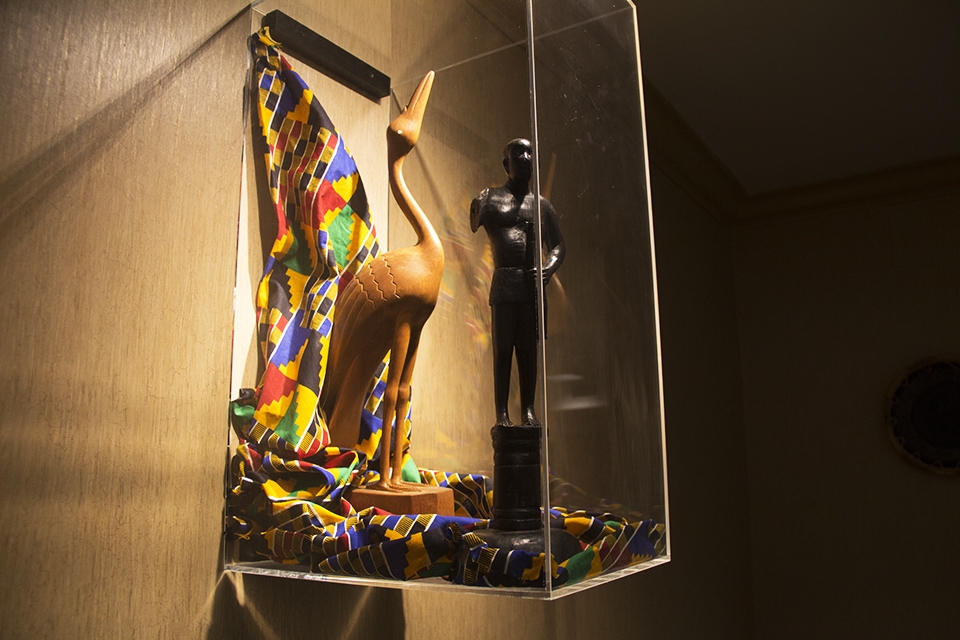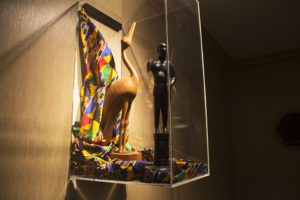
The two-case Spiritan exhibit featured a wide array of artifacts, including a beaded collar, wooden urn and ebony statues.

The two-case Spiritan exhibit featured a wide array of artifacts, including a beaded collar, wooden urn and ebony statues.
Gabriella DiPietro | Assistant News Editor
04/19/2018
Duquesne University values its Spiritan roots, and to honor the work of these Spiritans, a class of graduate students designed a new exhibit on campus.
The Museum Exhibits and Management class began the project at the beginning of the semester in January, creating and organizing an exhibit showcasing the work of the Spiritan Ministry in Africa.
The exhibit consists of two cases located in the Union’s Africa Room, which were installed on Monday, April 16.
Alima Bucciantini, the professor of the class who has a doctorate in economic and social history, and Luci-Jo DiMaggio, director of Mission Animation, thought of the idea for the exhibit when Bucciantini was looking for a project for her class to take on.
According to Bucciantini, the exhibit contains objects that have been collected by Spiritans while in Africa or brought here by African Spiritans, including a wooden urn and a beaded collar adorned with coins, aiming to highlight the deep and long connections between the Spiritan order and all corners of the African continent.
Working in teams of seven, students had to research the history of the Spiritan ministry in Africa, communicate with the Spiritan fathers at the Spiritan Retreat Center in Bethel Park, locate objects there, decide which objects to display and then decide how to arrange them in the display case.
Amber Kast, a first-year graduate student in the Public History Master’s program, shared what she loved most about the exhibit and her contributions to it.
“My favorite aspect of the exhibit is getting to create one before graduating, and also to be able to come back years down the line and be able to point it out to others, saying that it was one of my first exhibits,” said Kast.
Grant Stoner, a first-year public history graduate student and Duke A&E writer, noted that many people are not familiar with the Spiritans and their work, and he hopes the exhibit will serve to change that.
“The Spiritans are a relatively unknown organization within the Catholic Church. Despite their missionary efforts within Africa, Latin America, Asia and Australia, people are relatively unaware of their existence,” said Stoner. “Through these cases, we have the capability to educate faculty and students regarding this sect of Catholicism. Like all museum exhibits, we designed these cases to teach. Hopefully after viewing these objects, people will have the desire to seek out more information.”
Another student in the class, Amanda Seim, explained her thoughts on why people should take the time to visit the exhibit.
“I think the exhibit is important for Duquesne students and staff to experience because it helps them to learn more about the Spiritans and the impact they have had outside of Pittsburgh,” Seim said.
Bucciantini also described the exhibit’s important connection to the university.
“This is central to the mission and values of Duquesne,” said Bucciantini. “The new strategic plan concentrates on the Spiritan identity of the University, and this is one reason for making these new cases — To bring the Spiritan identity, history and ongoing work in Africa to the forefront of the mind of everyone who uses the Africa Room.”
Kast further explained the importance of the exhibit, noting that many students, herself included, are not aware of depth of the university’s connection to the Spiritan order.
“[The exhibit] emphasizes the Spiritan mission and the influence this religious group had on tribes in Africa,” said Kast. “It wasn’t something that I was familiar with going in, and it’s an intriguing part of Duquesne’s past and the Spiritan past, and as a Spiritan school, it’s important that we learn about these aspects of history.”
The exhibit was funded by the Division of Mission and Identity and the Office of Freshman Development, and it was made possible by the Mission Ambassadors project.
“We were excited to fund a project that highlighted such an important part of our Spiritan history,” said DiMaggio. “Highlighting the Spiritans’ work in Africa through the exhibit was such a unique way to tie our Mission and history into a class on campus.”
An unveiling ceremony and reception was held on Wednesday, April 18 from 4 to 6 p.m. in the Africa Room.




